| Resophonic Capos |
| There are three main principles for capoing resophonic instruments. The first and obvious method is to slip something under the strings, lifting them up slightly. This type of capo is always made by hand because it has to fit the individual
instrument. They are usually L shaped metal, just tall enough to set at a slight angle
under the strings, than twisting to level it and lift the strings slightly. |
The Church Key
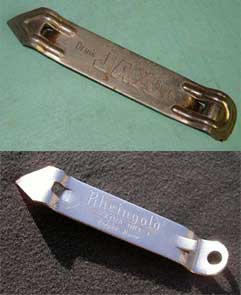
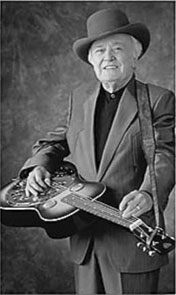
Josh Graves told that in his early career he used a beer
can opener as a capo: In the US canned beer first appeared in 1935 with flat top tin cans that required an opener. These openers were provided with the beer, and would have a beer compay logo on them. They were commonly referred to as "church keys". In 1962 the first "pop top" beer cans were introduced making the "church key" obsolete. |
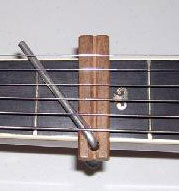 |
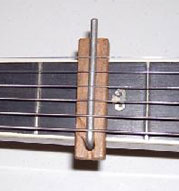 |
R Q Jones
|
| Rudy Jones, Oklahoma made a few of these capos
in the late 1970's. It consists of a block of walnut with a groove on the bottom side to
fit over the fret, with a stainless steel rod (from a bakers shelf) bent and inserted
through a hole with a vinyl cap to keep it from falling out. To operate, rotate the rod counter clockwise into the deep groove away from the centerline of the wood, slip the wood under the strings with the groove over the fret, then rotate the steel rod clockwise under the strings into the groove in the top of the wood. It works pretty well on the first 2 or 3 frets. [Owner: Roy Barnes, Oklahoma.] |
||
 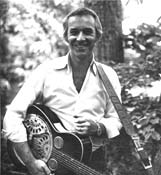 |
Bar under the strings This is my own home made capo made out of a brass rod, rounded in one end. It's flat underneath with a groove for the fret. The groove stops at a small distance from the bass end of the bar. It works on the first three frets. I have another, slightly thicker capo for capoing higher up the neck. Mike Auldridge uses a similar capo. Instead of using two capos, he slips a brass plate under the capo when capoing higher. The plate has a grove to fit on the fret and a ridge on the top side to emulate a fret. |
![]()
The next method is to press the strings down on the capo bar.
Warning: Don't use capos of this type on resophonic guitars
with a hollow neck!
| Whilbro This capo was made in 1977 or 78 by Bent Whilbro in Denmark. The capo has a high brass fret that is put right on top of the instrument frets. The hight of the fret equals the string hight. Two pieces of aluminum of the same hight as the fret are fastened with screws on each side. They are placed a little off center to make a groove at the bottom for the instrument frets and make the top of the fret stand out by it self. The fretboard is protected by thin, green felt and there is a thin rubber pad for the strings. By fastening the brass fret to the front side of the capo, the strings are pressed down right behind the fret - as a capo should. Clever! [Owner: John Ried, Sweden.] |
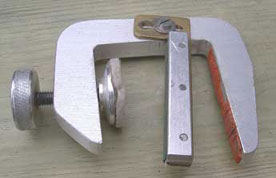 |
| Jim Dunlop A bar to slip under the strings is added to a regular elastic capo. The bar acts as an elevated fret and the capo presses the strings down and mutes the strings behind the bar. It was patented as a "Guitar Converter" to facilitate slide playing on a regular guitar. US patent 1976 by Jim Dunlop. Marketed by Jim Dunlop. [Owner: Philippe Saint-Pierre, France.] |
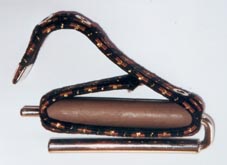 |
|
Von Andreae When the elastic was worn out, this Dunlop capo was modified by attaching a piece of plastic to it with dental floss. The plastic fits over the fret and its springy curvature presses the steel bar up against the strings. The elastic band is obsolete. The little plastic cap keeps the roller pad in its place. [Owner: Bengt Von Andreae, Sweden.] |
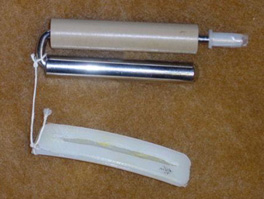 |
| Golden Gate Inspired of the capo above, this
capo was designed for resophonic guitars. A Delrin spacer is fastened to the bar. Three
spacers are provided to accommodate different string action heights. |
|
| Kyser On this one the strap is replaced with a hinged bar which is turned in under the instrument neck. The thin, silicone coated bar is placed under the strings and the thick brass bar on top of the strings. Note that the thick bar is fastened eccentrically to the frame. Thus it can be rotated to set the tension and it is fastened with the allen wrench. |
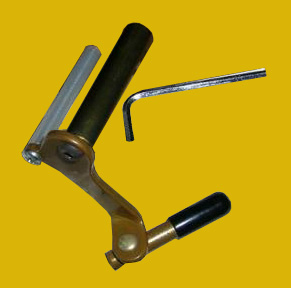 |
| Shubb Shubb added a bar to slip under the strings to his original capo construction. The strings must be 3/8" off the fretboard. This capo is approved to be the official Dobro® capo. |
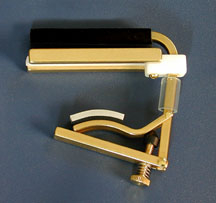 |
![]()
The third method is to clamp a weight to the strings. For practical reasons
the weight is always
above the strings.
 |
Huckabee In the early 1980's this was one of the first commercially produced dobro capos, designed by Dan Huckabee. A thin, round bar with plastic tubing, pulls the strings up towards the heavy, square bar by means of a screw and a wing nut. Along the bottom side of the square bar there is a routed grove to give it two distinct edges against the strings and the strings are pulled into that grove. The round bar is incerted between the 3rd and 4th strings. |
| Liberty A developement of the capo above is
to replace the wing nut with an eccentric lever. This capo is now (2006) resurrected under another brand and |
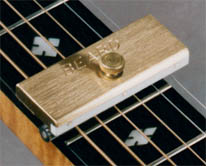 |
 |
Beard |
| This is a refined variation of the capo above.
The sqare brass bar is wider and lower. Instead of a routed grove, this capo has a bone
edge and a leather pad to mute the strings behind the capo. Designed by Paul E Beard in 1985. |
||
Warren |
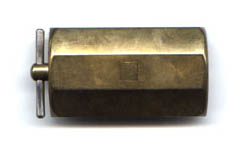 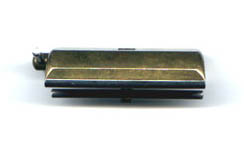 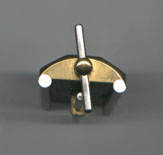 |
| From the mid-1980's, beautifully hand made by Jim Warren, of Owensboro,
KY. You turn it 90 degrees and slip the rod between the strings and then rotate it back
perpendicular to the strings. Then you turn the lever to an eccentric cam built into the body 180 degrees (either way), which lifts the bar, cinching up the strings against stainless rods attached underneath. The string tension holds the cam in a little detent, which keeps it from coming loose. This manouver was difficult to do with a bar in one hand and fingerpicks on the other. [Owner: Tim Mullins, California USA.] |
Bradley |
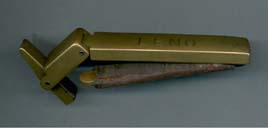 |
Leno The rubber sleeved bar is slipped under the strings and the capo is closed by the hinged lever. When closed the thiner point of the lever points down along the bass side of the neck. |
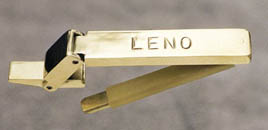 |
Production ceased in mid 1990's, but has started again. Here is a new one. US
patent in 1987 by Emmet L Hathcock. |
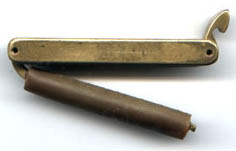 |
Sheerhorn A
real early all-brass Sheerhorn, before he started plating them. |
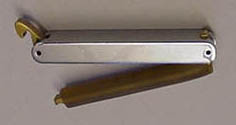 |
The locking mechanism is a hook snapping over the
end of the rubber sleeved bar. [Owner: Jonas Kjellgren, Sweden.] |
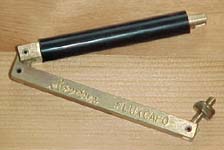 |
Sheerhorn Fluxcapo Here the square bar is thin and slips under the strings. The upper side of the square bar is slightly concave to fit the round padded bar and make a distinct edge. It works perhaps better upside-down. You can clamp it with one finger hooking over the end, and putting the rubber padding underneath keeps the capo from knocking on the fretboard when you hammer-on. Designed by Jerry "Flux" Douglas. |
Koyama
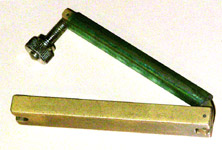
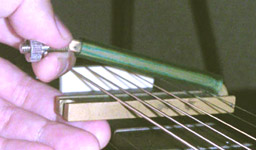
| The same idea as the Fluxcapo, but the parts are reversed. This makes the
bar slim and the heavy weight is placed out of the way under the strings. Made by Tetsuo Koyama, Japan. [Owner: Shinji Kojima, Japan.] |
 |
Wilson Similar to the Leno capo, but here the clamping force is adjustable by means of a screw. Custom-made by Merv Wilson in Ottawa, Canada. More info here. |
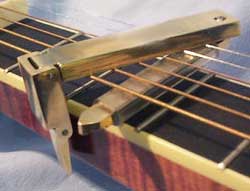 |
Holoubek Another one similar to the Leno capo. Here the bar is turned sideways to open. Made by Stepan Holoubek, Czech Republic. |
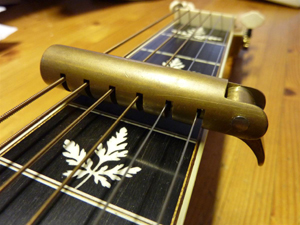 |
Pothoven |
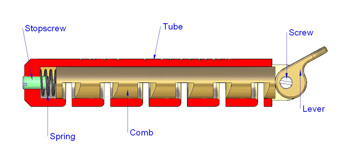 |
|
| Here is a clever capo. Quickly
operated with one hand. It will allways set itself perpendicular
to the strings. The capo is fastened to the strings by lowering the
lever. Due to the precision required this capo has to custom made for
the string gauges and string spacing you are using. It's not cheap
either, but for you who wants that little extra you can order it from: Wouter Pothoven, Netherlands. www.wpstrings.com |
|
![]()